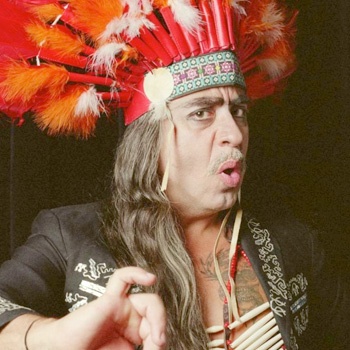Guillermo Gomez-Peña
Guillermo Gomez-Peña
Performance artist, writer, activist, radical pedagogue, director of the performance troupe La Pocha Nostra
MLK Visiting Scholar 1999-2000
Hosted as an MLK Artist in Residence

Bio
Guillermo Gomez-Peña is a performance artist, writer, activist, radical pedagogue, and director of the performance troupe La Pocha Nostra. He is a contributing editor to The Drama Review (NYU-MIT). His performance works and many publications have contributed to the debates on cultural diversity, border culture, and US-Mexico relations.
Born in 1955 and raised in Mexico City, Gómez-Peña came to the US in 1978. His work, which includes performance art, video, audio, installations, poetry, journalism, and cultural theory, explores cross-cultural issues, immigration, the politics of language, "extreme culture" and new technologies in the era of globalization. A MacArthur fellow, he is a regular contributor to the national radio news magazine All Things Considered (National Public Radio), a writer for newspapers and magazines in the U.S. and Mexico, and a contributing editor to The Drama Review (MIT).
For twenty years, Gómez-Peña has been exploring intercultural issues with the use of mixed genres and experimental languages. Continually developing multi-centric narratives and large-scale performance projects from a border perspective, Gómez-Peña creates what critics have termed "Chicano cyber-punk performances," and "ethno-techno art." In his work, cultural borders have moved to the center while the alleged mainstream is pushed to the margins and treated as exotic and unfamiliar, placing the audience members in the position of "foreigners" or "minorities."
Gómez-Peña’s performance and installation work has been presented at over seven hundred venues across the U.S., Canada, Mexico, Europe, Australia, the Soviet Union, Colombia, Puerto Rico, Cuba, Brazil and Argentina (see below).
Among numerous fellowships and prizes, Gómez-Peña was a recipient of the Prix de la Parole at the 1989 International Theatre of the Americas (Montreal), the 1989 New York Bessie Award, and the Los Angeles Music Center’s 1993 Viva Los Artistas Award. In 1991, Gómez-Peña became the first Chicano/Mexicano artist to receive a MacArthur Fellowship (1991-1996). In 1995, he was included in The UTNE Reader’s "List of 100 Visionaries." In 1997 he received the American Book Award for The New World Border. In 2000, he received the Cineaste lifetime achievement award from the Taos Talking Pictures film festival.
Chronicles, essays and scripts of his large-scale projects can be found in five of his books: Dangerous Border Crossers (Routledge, 2000), Codex Spangliensis (City Lights, 2000), Mexican Beasts and Living Santos (PowerHouse, 1997), The New World Border (City Lights, 1996) and Warrior for Gringostroika (Graywolf, 1994).
The film version of his solo performance Border Brujo (in collaboration with Isaac Artenstein), was awarded first prize in the 1991 National Latino Film and Video Festival and first prize in the category of "Performance Film" at Cine Festival (San Antonio 1991). His videos, El Naftazteca: Cyber Aztec TV for 2000 AD and Temple of Confessions were awarded first prizes at Cine Festival in San Antonio, Texas in 1996 and 1998, respectively. In 2001, his film Borderstasis was awarded the prize for "best performance video" from the Vancouver Video Poetry Festival. His work was recently featured in the HBO special "Americanos."
In 1999, MIT hosted Gómez-Peña as an MLK Visiting Scholar and Artist-in-Residence.
Video
Couple in the Cage (Third World Newsreel)
Over the last five hundred years, non-western human beings have been exhibited in the taverns, theaters, gardens, museums, zoos, circuses and world's fairs of Europe, and the circuses and freak shows of the United States. In commemoration of this practice, video maker Coco Fusco and performance artist Guillermo Gomez-Pena lived in a gilded cage in Columbus Plaza in Madrid for three days in May 1992. Presenting themselves as aboriginal inhabitants of an island in the Gulf of Mexico that was overlooked by Columbus, the video documents "authentic" and "traditional" tasks, including writing on a laptop computer, television, sewing voodoo dolls and working out.